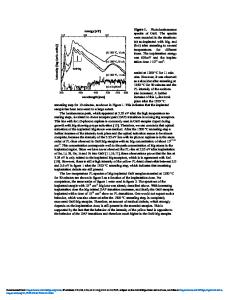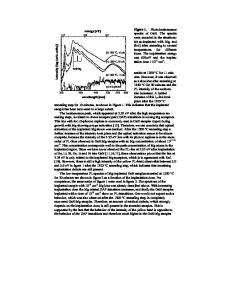Characterization of Ion Implanted GaN
- PDF / 213,990 Bytes
- 6 Pages / 612 x 792 pts (letter) Page_size
- 25 Downloads / 352 Views
Characterization of Ion Implanted GaN B.J. Skromme, G.L. Martinez, L. Krasnobaev1, and D.B. Poker2 Department of Electrical Engineering and Center for Solid State Electronics Research Arizona State University, Tempe, AZ 85287-5706, U.S.A. 1 Implant Sciences Corp., Wakefield, MA 01880 2 Oak Ridge National Laboratory, Oak Ridge, TN 37831 ABSTRACT Low temperature photoluminescence is used to study the levels introduced by low-dose implantation of Mg, C, and Be into GaN, together with Ne, Al, P, or Ar co-implantation species. None of the co-implants successfully creates shallow C or Be acceptors. The yellow (2.2 eV) PL band is strongly introduced by both C and Be implants, but not by Ar, Al, P, or Mg. We propose that it involves Ga vacancies stabilized by complexing with C and Be interstitial (or CGa) donors, which explains why C and Be are absent as substitutional acceptors. We observe excitons bound to isoelectronic PN in P-implanted GaN. They are absent in P+Mg implanted GaN, in which we observe new donor-to-acceptor pair peaks due to two deeper donor levels. We assign these levels to PGa antisite double donors, which are stable in p-type material INTRODUCTION Selective doping is essential in any well-developed semiconductor technology. Diffusion of most impurities in GaN is so slow, however, that it is impractical. Ion implantation is the only presently viable method to dope GaN selectively. The behavior of implanted acceptors is not well understood in GaN at present. In previous work, we studied Mg, C, and Be acceptors implanted into high purity GaN at low enough doses to permit detailed spectroscopic characterization using low temperature photoluminescence (PL) [1]. Good optical activation of Mg acceptors was obtained, yielding a spectroscopic binding energy of 224 meV from the conduction band-to-acceptor (e-Ao) peak position. A green band at 2.35 eV and a weaker red band at 1.73 eV were also observed. Similar C and Be implantations produced mainly a dosecorrelated increase in the yellow PL band at 2.2 eV. In the present work, we extend this study to include damage-only implants, and to study the effects of co-implantation with Ne, Al, P, and Ar. The idea of co-implantation is to create additional vacancies with heavier co-implant species, to improve the incorporation of the lighter C and Be species on the appropriate substitutional sites. Group III or V co-implant species (Al or P) may also alter the stoichiometry in a way that encourages substitution on the desired site. Co-implantation with P has been used to improve electrical activation of implanted Mg and Ca in GaN [2, 3], but no spectroscopic measurements were performed. EXPERIMENTAL PROCEDURE The starting material for the implantations described here consisted of not intentionally doped hydride vapor phase epitaxial (HVPE) layers on sapphire(0001) substrates, about 4.2, 6.5, or 20 µm thick, with residual n-type doping in the mid 1016 to 1x1017 cm-3 range. Co-implanted samples were implanted using four energies and doses, to produce an approximately flat co
Data Loading...











